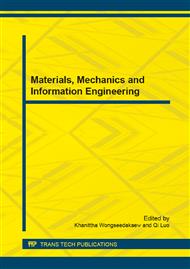[1]
ANSYS, Inc. Release 14. 5 Documentation for ANSYS. Southpointe 275 Technology Drive Canonsburg, PA 15317, (2012).
DOI: 10.1016/b978-0-12-811768-2.00022-5
Google Scholar
[2]
LS-DYNA keyword user's manual, version 970. Livermore Software Technology Corporation; (2003).
Google Scholar
[3]
ATENA Program Documentation, Cervenka consulting Ltd., (2013).
Google Scholar
[4]
Multiplas, User's Manual Release 5. 0. 679 for ANSYS 14. 0 and ANSYS 14. 5, Dynardo, Weimar, Germany, (2013), www. dynardo. de.
Google Scholar
[5]
S. Kumar, S. V. Barai, Concrete fracture models and applications. Berlin: Springer-Verlag, (2011), xxii, 262 p. ISBN 978-3-642-16763-8.
Google Scholar
[6]
F. Hokes. Different Approaches to Numerical Simulations of Prestressed Concrete Structural Elements. In proceeding: Applied Research in Materials and Mechanics Engineering. Vol. 621 (2014), ISSN: 1660-9336. p.148.
DOI: 10.4028/www.scientific.net/amm.621.148
Google Scholar
[7]
P. Hradil, J. Kala. Analysis of the Shear Failure of a Reinforced Concrete Wall. In proceeding of: Applied Research in Materials and Mechanics Engineering. Vol. 621 (2014), ISSN: 1660-9336. p.120.
DOI: 10.4028/www.scientific.net/amm.621.124
Google Scholar
[8]
M. Jirásek, J. Zeman. Přetváření a porušování materiálů: dotvarování, plasticita, lom a poškození. 1. ed. Praha: Nakladatelství ČVUT, (2006), 175 p. ISBN 978-80-01-03555-9.
Google Scholar
[9]
Z. P. Bažant, J. Planas,. Fracture and Size Effect in Concrete and Other Quasi-brittle materials. Boca Raton: CRC Press (1998).
Google Scholar
[10]
C. E. Inglis, Stresses in a plate due to presence of cracks and sharp corners. Trans. Inst. Naval Archit. vol. 55 (1913), pp.214-291.
Google Scholar
[11]
A. A. Griffith, The phenomena of rupture and flow in solids. Phil. Trans. vol. 221A (1921), pp.179-180.
Google Scholar
[12]
G. R. Irwin, Analysis of stresses and strains near the end of a crack traversing a plate, J Appl. Mech. Trans. ASME vol. 24 (1957), pp.361-364.
DOI: 10.1115/1.4011772
Google Scholar
[13]
Y. S. Jenq, S. P. Shah, Two parameter fracture model for concrete. J. Eng. Mech. ASCE vol. 111 (10) (1985), pp.1227-1241.
DOI: 10.1061/(asce)0733-9399(1985)111:10(1227)
Google Scholar
[14]
B. L. Karihaloo, P. Nallathambi, An improved effective crack model for the determination of fracture toughness of concrete. Cem. Concr. Res. vol. 19 (1989), pp.603-610.
DOI: 10.1016/0008-8846(89)90012-4
Google Scholar
[15]
RILEM Draft Recommendations (TC89-FMT), Size-effect method from determining fracture energy and process zone size of concrete. Mater. Struct. vol. 23 (138) (1990), pp.461-465.
DOI: 10.1007/bf02472030
Google Scholar
[16]
S. Xu, H. W. Reinhardt, Determination of double-K criterion for crack propagation in quasi-brittle materials Part I: experimental investigation of crack prapagation, Int. J. Fract. vol. 92 (1999), pp.111-149.
Google Scholar
[17]
S. Xu, H. W. Reinhardt, Determination of double-K criterion for crack propagation in quasi-brittle materials Part II: enalytical evaluating and practical measuring methods for three point bending notched beams. Int. J. Fract. vol. 98 (1999).
Google Scholar
[18]
S. Xu, H. W. Reinhardt, Determination of double-K criterion for crack propagation in quasi-brittle materials Part III: compact tension specimens and wedge splitting specimens. Int. J. Fract. vol. 98 (1999), pp.179-193.
Google Scholar
[19]
S. Xu, X. Zhang, Determination of fracture parameters for crack propagation in concrete using an energy approach. Eng. Fract. Mech. vol. 75 (2008), pp.4292-4308.
DOI: 10.1016/j.engfracmech.2008.04.022
Google Scholar
[20]
A. Hillerborg, A. Modeer, P. E. Petersson, Analysis of crack formation and crack growth in concrete by means of fracture mechanics and finite elements. Cem. Concr. Res. vol. 6 (1976), pp.773-782.
DOI: 10.1016/0008-8846(76)90007-7
Google Scholar
[21]
Z. P. Bažant, B. H. Oh, Crack band theory for fracture of concrete. Mater. Struct. vol. 16 (93), (1983), pp.155-177.
Google Scholar
[22]
R. Mises, Mechanik der festen Körper im plastisch deformablen Zustand. Göttin. Nachr. Math. Phys. vol. 1 (1913), p.582–592.
Google Scholar
[23]
W. Rankine, On the stability of loose earth. Philosophical Transactions of the Royal Society of London, Vol. 147 (1857).
Google Scholar
[24]
D. C. Drucker, W. Prager. Soil Mechanics and Plastic Analysis or Limit Design. Quarterly of Applied Mathematics. vol. 10. 2 (1952), pp.157-165.
DOI: 10.1090/qam/48291
Google Scholar
[25]
M. Sharafisafa, M. Nazem, Application of the distinct element method and the extended finite element method in modelling cracks and coalescence in brittle materials. Computational Materials Science, Vol. 91 (2014).
DOI: 10.1016/j.commatsci.2014.04.006
Google Scholar
[26]
J. Eliáš, M. Vořechovský, Discrete numerical simulation of fracture propagation in disordered materials: mesh dependency, In proceeding of: 17th European Conference on Fracture, ISBN 9781617823190, Czech Republic (2008).
Google Scholar
[27]
J. Alfaiate, E.B. Pires, J.A.C. Martins, A finite element analysis of non-prescribed crack propagation in concrete, Computers & Structures, Vol. 63, Issue 1 (1997), pp.17-26, ISSN: 0045-7949, http: /dx. doi. org/10. 1016/S0045-7949(97)85247-9.
DOI: 10.1016/s0045-7949(97)85247-9
Google Scholar
[28]
L. Jurášek, P. Hradil, P. Vymlátil, Analýza smykového porušení železobetonové stěny. In proceeding of: 20th SVSFEM ANSYS Users Group Meeting and Conference, (2012).
Google Scholar
[29]
N. Moës, J. Dolbow, T. Belytschko, A finite element method for crack growth without remeshing. Int. J. Numer. Meth. Engng., vol. 46 (1999), p.131–150.
DOI: 10.1002/(sici)1097-0207(19990910)46:1<131::aid-nme726>3.0.co;2-j
Google Scholar
[30]
Wikipedia, the free encyclopedia, Extended finite element method, (2014) Information on: http: /en. wikipedia. org/wiki/Extended_finite_element_method.
Google Scholar
[31]
L.J. Malvar, J. E. Crawford, J. W. Wesevich. A plasticity concrete material model for Dyna3D. Int. J. Impact. Eng. vol. 19(9–10) (1997), p.847–873.
DOI: 10.1016/s0734-743x(97)00023-7
Google Scholar


